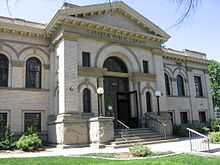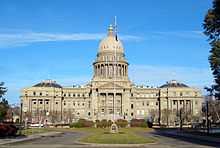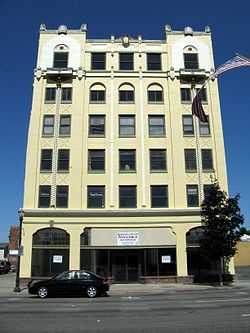John E. Tourtellotte
| John E. Tourtellotte | |
|---|---|
| Born |
John Everett Tourtellotte February 22, 1869 East Thompson, Connecticut |
| Died |
May 8, 1939 (aged 70) Portland, Oregon |
| Nationality | American |
| Occupation | Architect |
| Spouse(s) | Della Wallace Tourtellotte (1869–1946) |
| Children | 2 |
| Practice |
John E. Tourtellotte & Company; Tourtellotte & Hummel |
John Everett Tourtellotte (February 22, 1869 – May 8, 1939) was a prominent western American architect, best known for his projects in Idaho. His work in Boise included the Idaho State Capitol, the Boise City National Bank, the Carnegie Library, and numerous other buildings for schools, universities, churches, and government institutions.[1] From 1922 to 1930, he worked in Portland, Oregon.


He was associated with partnerships John E. Tourtellotte & Company and Tourtellotte and Hummel, based in Boise. Works by these firms were covered in a 1982 study and many of the buildings were immediately or later listed on the National Register of Historic Places.[2][3]
Biography
Tourtellotte was born in East Thompson, Connecticut, to a well-respected French Huguenot family. His father, Charles W. Tourtellotte, was a prosperous farmer and grist-mill owner. At age 17, he enrolled as an apprentice to the architectural firm of Cutting & Bishop, based in Webster, Massachusetts, where he studied architectural drawing for two years. During this time, he supervised roof construction for the Butler Insane Asylum in Providence, Rhode Island, and the Anne & Hope factory in Lonsdale, which was then the largest factory in the United States.
Following his apprenticeship, Tourtellotte traveled westward, working on construction projects in Chicago, Kansas City, Albuquerque, and Pueblo, Colorado, before arriving in Boise in 1890, months after Idaho achieved statehood. His architectural and construction business thrived in Boise, and by 1894, Tourtellotte devoted his business entirely to architecture. In 1903, he formed a partnership with German immigrant Charles Hummel (1857–1939), a university-trained architect who had previously worked for Tourtellotte's architecture and construction business.[4] Though the firm's headquarters were moved to Portland in 1913, the Boise office was retained. The partnership was dissolved in 1922, and Tourtellotte then partnered with one of Charles Hummel's sons, fellow architect Frank K. Hummel (1892–1961). The two shared a Portland office from 1922 until Tourtellotte's retirement in 1930, and Frank Hummel worked there until its closure around 1934, when he returned to Boise. *Tourtellote continued to work as he designed a proposed Portland City Hall in 1933 with architect Truman E. Phillips as well as a completed project, Linn County Courthouse in Albany, OR, which was in the building stages at the time of his death, also with Mr. PHillips, according to "Architect and Engineer", Vols. 136-139, page 55.[5]
After retiring, Tourtellotte continued to live in Portland,[5] where he died on May 8, 1939.[6]
Tourtellotte was known for combining architectural motifs from disparate styles and eras, and the domed Idaho State Capitol is celebrated for its use of natural light. To celebrate the opening of the state capitol, Tourtellotte wrote an essay where he compared the architectural styles of various eras to the state of spiritual and moral development of civilization evident during those times, with the use of illumination and light signifying the increasing spiritual enlightenment of humanity.[7]
His most famous work, the Idaho State Capitol, underwent an extensive restoration which was completed in 2010.[8]
Tourtellotte also designed the replacement Administration Building at the University of Idaho in Moscow. Construction of the Tudor Gothic-style structure began in 1907 and the main building was completed in 1909; its wings in 1912 and 1916. Based on the Hampton Court Palace in England, the UI Administration Building is a campus icon and was added to the National Register of Historic Places in 1978, at age 69.[9]
Tourtellotte fraternal affiliations were with the Benevolent and Protective Order of Elks, the Freemasons, and the Kiwanis. [10]
Works

Works on the NRHP
Numerous buildings designed by Tourtellotte and associated firms are listed on the National Register of Historic Places.[3]
- Walter Abbs House, 915 Fort St, Boise, Idaho
- Ada Odd Fellows Temple, 109-115 ½ N 9th St, Boise
- Ada Theater, 700 Main St, Boise (attributed to Tourtellotte & Hummel)
- Administration Building, University of Idaho, Moscow, Idaho
- F. P. Ake Building, 106-72 Main St, Mountain Home, Idaho (Tourtellotte & Hummel)
- Marion Allsup House, 1601 N 10th, Boise
- Anderson-Elwell House, 547 W 1st St, Weiser, Idaho
- Bald Mountain Hot Springs, Main and 1st streets, Ketchum, Idaho (Tourtellotte & Hummel)
- Albert Beck House, 1101 Fort St, Boise
- F. T. Bliss House, E 2nd and McKinley streets, Emmett, Idaho
- Boise City National Bank, 8th and Idaho streets, Boise
- Boise High School Campus, Washington St between 9th and 11th streets, Boise (Tourtellotte & Hummel)
- Boise Junior College Administration Building, Boise State University campus, Boise (Tourtellotte & Hummel)
- Boise Junior High School, 1105 N 13th St, Boise (Tourtellotte & Hummel)
- Bruneau Episcopal Church, off Idaho State Highway 51, Bruneau, Idaho (Tourtellotte & Hummel)
- Brunzell House, 916 Franklin St, Boise
- H. H. Bryant Garage, 11th and Front streets, Boise (Tourtellotte & Hummel)
- H. C. Burnett House, 124 W Bannock St, Boise (Tourtellotte & Hummel)
- Butterfield Livestock Company House, north of Weiser on Jenkins Creek Rd, Weiser (Tourtellotte & Hummel)
- Caldwell Odd Fellow Home for the Aged, N 14th Ave, Caldwell, Idaho (Tourtellotte & Hummel)
- Carnegie Public Library, 815 Washington St, Boise
- Catholic Church of the Sacred Heart, 1st St, Emmett, Idaho (Tourtellotte & Hummel)
- Chinese Odd Fellows Building, 610-612 Front St, Boise (Tourtellotte & Hummel)
- Henry Coffin House, 1403 Franklin St, Boise
- Cole School and Gymnasium, 7145 Fairview Ave, Boise (Tourtellotte & Hummel)
- Collister School, 4426 Catalpa Dr, Boise (Tourtellotte & Hummel)
- Coos Bay National Bank Building, 201 Central Ave, Coos Bay, Oregon (Tourtellotte & Hummel)
- John Daly House, 1015 W Hays St, Boise (Tourtellotte & Hummel)
- Dr. James Davies House, 1107 W Washington St, Boise
- R. K. Davis House, 1016 Franklin St, Boise
- E. H. Dewey Stores, 1013-15 1st St S, Nampa, Idaho
- William Dunbar House, 1500 W Hays St, Boise (Tourtellotte & Hummel)
- Minnie Preist Dunton House, 906 Hays St, Boise
- Pedro Echevarria House, 5605 State St, Boise (Tourtellotte & Hummel)
- Echo City Hall, 20 S Bonanza St, Echo, Oregon
- Eichelberger Apartments, 612-24 N 9th St, Boise (Tourtellotte & Hummel)
- Elks Temple, 310 Jefferson St, Boise (Tourtellotte & Hummel)
- Farmers and Merchants Bank, 101 11th Ave S, Nampa (Tourtellotte & Hummel)
- Father Lobell House, 125 N 4th St E, Mountain Home, Idaho (Tourtellotte & Hummel)
- Alva Fleharty House, 907 Hays St, Boise
- Franklin School, 5007 Franklin Rd, Boise (Tourtellotte & Hummel)
- H. K. Fritchman House, 1207 W Hays St, Boise
- Bishop Funsten House, 2420 Old Penitentiary Rd, Boise
- J. H. Gakey House, 1402 Franklin St, Boise (Tourtellotte & Hummel)
- Garfield School, 1914 Broadway Ave, Boise (Tourtellotte & Hummel)
- Gooding College Campus, Idaho State Highway 26, Gooding, Idaho (Tourtellotte & Hummel)
- Gorby Opera Theater, Idaho St, Glenns Ferry, Idaho (Tourtellotte & Hummel)
- John Green Mausoleum, Morris Hill Cemetery, Boise
- Guernsey Dairy Milk Depot, 2419 State St, Boise (Tourtellotte & Hummel)
- Bernard Haas House, 377 E Main St, Weiser
- Herman Haas House, 253 W Idaho St, Weiser
- John Haines House, 919 W Hays St, Boise
- Samuel Hays House, 612 Franklin St, Boise (Tourtellotte & Hummel)
- Hotel Astoria (later renamed the John Jacob Astor Hotel), 342 14th Street, Astoria, Oregon
- Hotel North Bend, 768 Virginia St, North Bend, Oregon
- Fred Hottes House, 509 W Hays St, Boise
- E. F. Hunt House, 49 E State St, Meridian, Idaho (Tourtellotte & Hummel)
- Idaho Building, Bannock and 8th streets, Boise
- Idaho Grocery Warehouse and Annex, 1209 Main St, Lewiston, Idaho (Tourtellotte & Hummel)
- Idaho State Industrial School Women's Dormitory, west of St. Anthony on North Parker Hwy, St. Anthony, Idaho (Tourtellotte & Hummel)
- Idaho State Sanitarium Administration Building, northeast of Nampa on 11th Ave N, Nampa (Tourtellotte & Hummel)
- Immanuel Methodist Episcopal Church, 1406 Eastman St, Boise (Tourtellotte & Hummel)
- Intermountain Institute, Paddock Ave, Weiser (Tourtellotte & Hummel)
- Orville Jackson House, 127 S Eagle Rd, Eagle, Idaho (Tourtellotte & Hummel)
- N. A. Jacobsen Building, N 8th St and 1st Ave, Payette, Idaho
- J. M. Johnson House, 1002 Franklin St, Boise
- J. W. Jones Building, 104 Main St NE, Blackfoot, Idaho (Tourtellotte & Hummel)
- T. J. Jones Apartments, 10th and Fort streets, Boise
- Kieldson Double House, 413-415 Jefferson St, Boise
- Joseph Kinney Mausoleum, Morris Hill Cemetery, Boise,
- Knights of Pythias Lodge Hall, 30 E Idaho St, Weiser
- Kurtz–Van Sicklin House, 439 W 3rd St, Weiser (Tourtellotte & Hummel)
- Archie Larsen House, south of Weiser on Larsen Rd, Weiser
- Lewiston City Hall, 207 3rd St, Lewiston
- Lewiston Vineyards Gates, 18th Ave and 10th St, Lewiston (Tourtellotte & Hummel)
- Lithia Springs Hotel, 212 E Main St, Ashland, Oregon (Tourtellotte & Hummel)
- Mackay Episcopal Church, Park Ave and College St, Mackay, Idaho
- Main School, Jct of 7th Ave and Cushman St, Fairbanks, Alaska (Tourtellotte & Hummel)
- M. J. Marks House, 1001 Hays St, Boise
- Marshfield City Hall, 375 W Central Ave, Coos Bay
- H. E. McElroy House, 924 W Fort St, Boise
- J. S. McGinnis Building, 1st and Commercial streets, Glenns Ferry (Tourtellotte & Hummel)
- Willis Mickle House, 1415 N 8th St, Boise
- Mitchell Hotel, 10th and Front streets, Boise
- Morris Hill Cemetery Mausoleum, Morris Hill Cemetery, Boise (Tourtellotte & Hummel)
- Mountain Home Baptist Church, 265 N 4th St E, Mountain Home
- Nampa American Legion Chateau, 1508 2nd St S, Nampa (Tourtellotte & Hummel)
- Nampa and Meridian Irrigation District Office, 1503 1st St S, Nampa (Tourtellotte & Hummel)
- Nampa Department Store, 1st St S and 13th Ave, Nampa
- Nampa First Methodist Episcopal Church, 12th Ave S and 4th St, Nampa (Tourtellotte & Hummel)
- Nampa Presbyterian Church, 2nd St and 15th Ave S, Nampa (Tourtellotte & Hummel)
- W. Scott Neal House, 215 E Jefferson St, Boise (Tourtellotte & Hummel)
- H. R. Neitzel House, 705 N 9th St, Boise (Tourtellotte & Hummel)
- G. V. Nesbit House, 308 W Liberty St, Weiser
- New Plymouth Congregational Church, 207 Southwest Ave, New Plymouth, Idaho (Tourtellotte & Hummel)
- Axel Nixon House, 815 N Hays St, Boise
- Dr. J. R. Numbers House, 240 W Main St, Weiser (Tourtellotte & Hummel)
- O'Neill Brothers Building, Idaho St, Glenns Ferry (Tourtellotte & Hummel)
- Our Lady of Limerick Catholic Church, 113 W Arthur Ave, Glenns Ferry (Tourtellotte & Hummel)
- Owyhee County Courthouse, Idaho State Highway 45, Murphy, Idaho (Tourtellotte & Hummel)
- J. C. Palumbo Fruit Company Packing Warehouse Building, 2nd Ave and 6th St, Payette (Tourtellotte & Hummel)
- John Parker House, 713 Franklin St, Boise (Tourtellotte & Hummel)
- Charles Paynton House, 1213 N 8th St, Boise
- Pierce-Borah House, west of Garden City off U.S. 26, Garden City, Idaho
- Pilot Butte Inn,[6] formerly at 1121 Wall Street, Bend, Oregon; built 1917, NRHP-listed 1972, demolished 1973[11]
- Pine Creek Baptist Church, Main and S 3rd streets, Pinehurst, Idaho (Tourtellotte & Hummel)
- Redwoods Hotel, 310 NW 6th St, Grants Pass, Oregon (Tourtellotte & Hummel)
- John Regan American Legion Hall, 401 W Idaho St, Boise (Tourtellotte & Hummel)
- Fred Reiger Houses, 214 and 216-18 E Jefferson St, Boise
- Rosedale Odd Fellows Temple, 1755 Broadway, Boise
- Ross Fork Episcopal Church, Mission Rd, Fort Hall, Idaho
- Mrs. A. F. Rossi House, 1711 Boise Ave, Boise (Tourtellotte & Hummel)
- Roswell Grade School, Idaho 18 and Stephan Lane, Roswell, Idaho (Tourtellotte & Hummel)
- Sacred Hearts of Jesus and Mary Church, 608 7th St, Parma, Idaho (Tourtellotte & Hummel)
- H. A. Schmelzel House, 615 W Hays St, Boise
- Adolph Schreiber House, 524 W Franklin St, Boise (Tourtellotte & Hummel)
- William Sidenfaden House, 906 Franklin St, Boise (Tourtellotte & Hummel)
- W. A. Simpson House, 1004 N 10 St, Boise
- Nathan Smith House, southwest corner of Broadway Ave and Targee Ave, Boise
- Morris Sommer House, 548 W 2nd St, Weiser
- Mary Elizabeth Sommercamp House, 411 W 3rd St, Weiser
- South Boise Fire Station, 1011 Williams St, Boise (Tourtellotte & Hummel)
- St. Agnes Catholic Church, 204 E Liberty St, Weiser (Tourtellotte & Hummel)
- St. Alphonsus' Hospital Nurses' Home and Heating Plant/Laundry, N 4th St between Washington and State streets, Boise (Tourtellotte & Hummel)
- St. Charles of the Valley Catholic Church and Rectory, Pine and S 1st streets, Hailey, Idaho (Tourtellotte & Hummel)
- St. John's Cathedral, 8th and Hays streets, Boise (Tourtellotte & Hummel)
- St. John's Cathedral Block, 8th and Hays, 9th and Fort streets, Boise (Tourtellotte & Hummel)
- St. Joseph's Catholic Church, 1st Ave and Cedar St, Bovill, Idaho (Tourtellotte & Hummel)
- St. Mary's Catholic Church, State and 26th streets, Boise (Tourtellotte & Hummel)
- St. Mary's Catholic Church, 616 Dearborn St, Caldwell (Tourtellotte & Hummel)
- St. Paul's Rectory and Sisters' House, 810 15th Ave S, Nampa (Tourtellotte & Hummel)
- Louis Stephan House, 1709 N 18th St, Boise (Tourtellotte & Hummel)
- A. K. Steunenberg House, 409 N Kimball Ave, Caldwell
- Thompson Mortuary Chapel, 737 Main St, Gooding (Tourtellotte & Hummel)
- John Tourtellotte Building, 210-222 N 10th St, Boise (Tourtellotte & Hummel)
- Trinity Episcopal Church, 7th and Idaho streets, Gooding
- Union Block and Montandon Buildings, 8th and Idaho streets, Boise
- University of Idaho Gymnasium and Armory, University of Idaho campus, Moscow,
- B. S. Varian House, 241 Main St, Weiser
- J. N. Wallace House, 1202 Franklin St, Boise
- Washington County Courthouse, E Court St, Weiser (Tourtellotte & Hummel)
- C. H. Waymire Building, 1521 N 13th St, Boise
- Weiser Post Office, Main and W 1st streets, Weiser (Tourtellotte & Hummel)
- Edward Welch House, 1321 E Jefferson St, Boise (Tourtellotte & Hummel)
- Wellman Apartments, 5th and Franklin streets, Boise (Tourtellotte & Hummel)
- West Point Grade School, off I-86, Wendell, Idaho (Tourtellotte & Hummel)
- Whitney School, 1609 S Owyhee St, Boise (Tourtellotte & Hummel)
- Wolters Double Houses, 712-16, 720-22 N 8th St, Boise
- Woodward Building, 23 8th St, Payette
- Zurcher Apartments, 102 S 17th St, Boise (Tourtellotte & Hummel)
Other works
- Eaton Hall, Willamette University, Salem, Oregon[12]
References
- ↑ http://idahoptv.org/productions/specials/capitoloflight/architects.cfm
- ↑ Patricia Wright (September 22, 1982). "Tourtellotte and Hummel Architecture Thematic Resources" (PDF). National Register of Historic Places. National Park Service.
- ↑ 3.0 3.1 "National Register Information System". National Register of Historic Places. National Park Service. 2009-03-13.
- ↑ History of Idaho. French, Hiriam T. The Lewis Publishing Company, 1914.
- ↑ 5.0 5.1 George T. Murphy (May 5, 1979). "National Register of Historic Places Inventory – Nomination Form: John Jacob Astor Hotel" (PDF). National Park Service. Item 8, p. 2. Retrieved October 10, 2013.
- ↑ 6.0 6.1 "Death Summons Noted Architect" (May 10, 1939). The Oregonian, p. 11.
- ↑ "John E Tourtellotte: A Western Visionary" (PDF). About the History of Idaho's Capitol. Idaho Capitol Commission. p. 2. Retrieved December 13, 2013. (Note: The full essay is also included in the same PDF document, near the end.)
- ↑ http://idahoptv.org/productions/specials/capitoloflight/
- ↑ University of Idaho - special collections - UI buildings - A - accessed 2010-03-23
- ↑ "Multnomah County OR Archives Biographies". http://files.usgwarchives.net''. The S. J. Clarke Publishing Company.
- ↑ Paul Hartwig (June 1972). "National Register of Historic Places Inventory – Nomination Form: Pilot Butte Inn" (PDF). National Park Service. Retrieved October 13, 2013.
- ↑ "Guide to the Fletcher P. Homan papers 1902–1923 at the Mark O. Hatfield Library". Northwest Digital Archives. Retrieved July 25, 2011.
External links
- Idaho Capitol Commission - original architect - John E. Tourtellotte
- Multnomah County archives John Tourtellotte
- John Tourtellotte Architecture on Google maps
|



